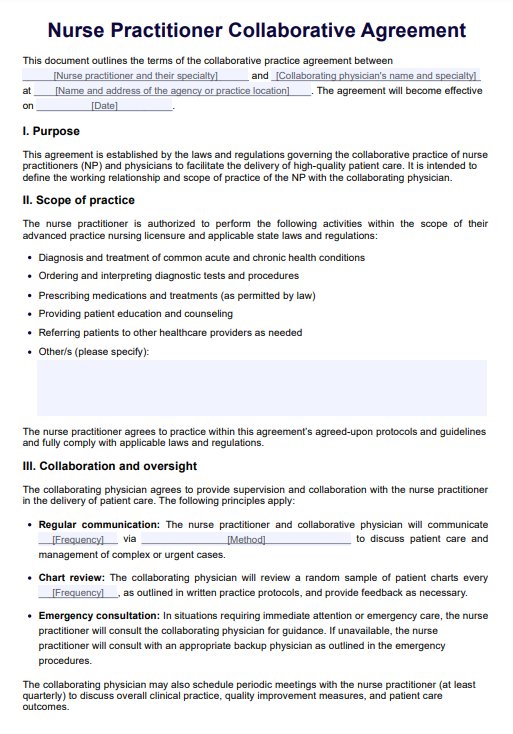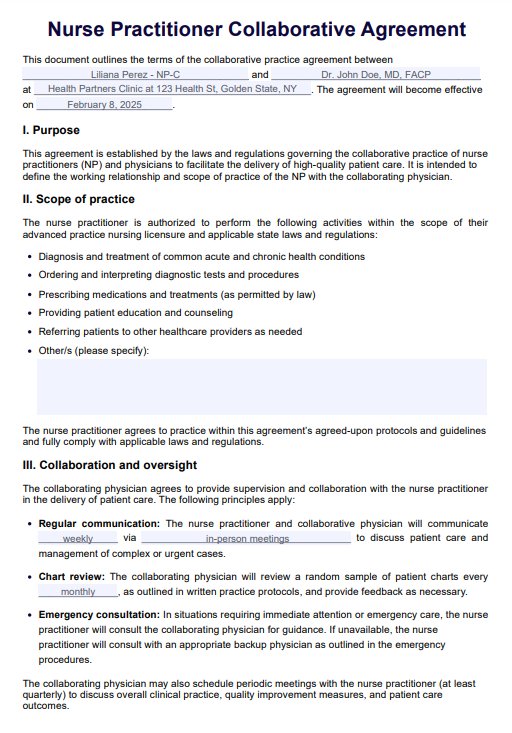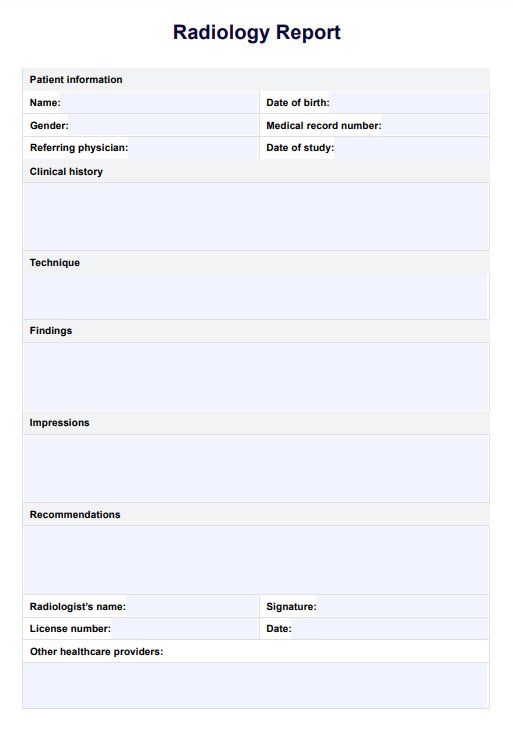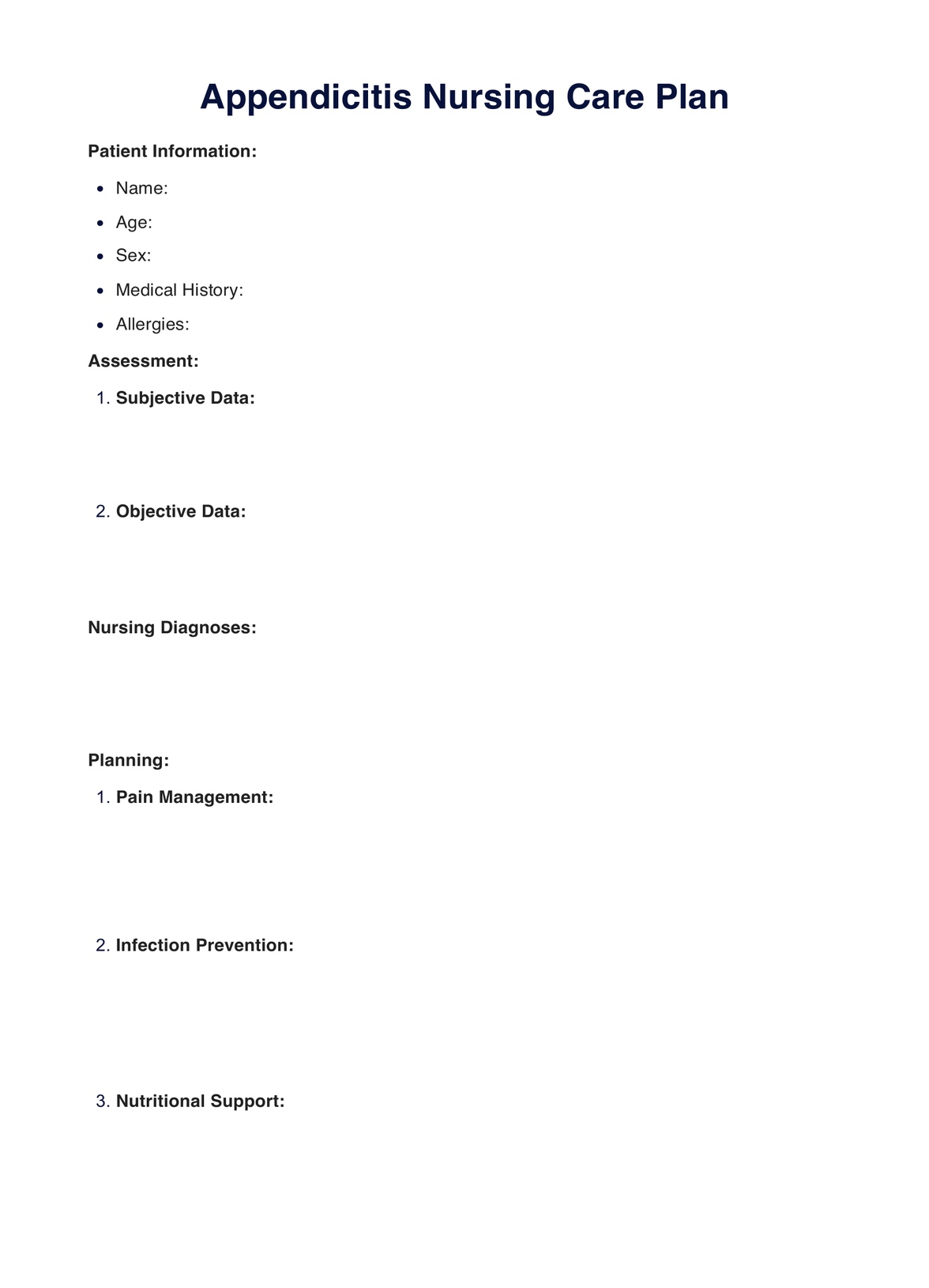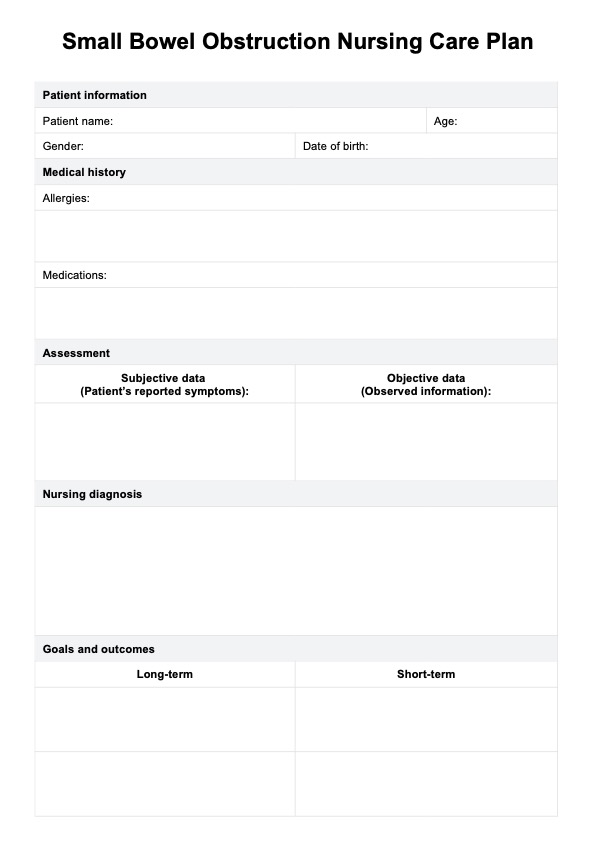Nurse Practitioner Collaborative Agreement Template
Create a professional Nurse Practitioner Collaborative Agreement Template with our easy-to-use template. Get this for free now to get started!


What is a Nurse Practitioner Collaborative Agreement Template?
A nurse practitioner collaborative agreement is a formal, written agreement between a nurse practitioner (NP) and a collaborating physician outlining each party's obligations, roles, and duties when providing health care services to patients. The agreement typically addresses the nurse practitioner's scope of practice, specifying the medical duties and procedures the NP is authorized to undertake, including the capacity to prescribe drugs and restricted substances.
This written collaborative agreement enables nurse practitioners to practice within their licensing and advanced practice training while adhering to regulatory regulations and state law. It also guarantees that collaborating physicians can provide supervision, review medical records, and offer advice, mainly when the NP works autonomously within their practice environment.
Nurse Practitioner Collaborative Agreement Template
Nurse Practitioner Collaborative Agreement Template Example
How does it work?
Using the Nurse Practitioner Collaborative Agreement Template helps ensure clear roles and compliance with relevant laws and regulations when establishing a collaborative practice between nurse practitioners and a collaborating licensed physician. Follow these steps to use the template:
Step 1: Access the template
You can access the Nurse Practitioner Collaborative Agreement Template within this guide. Click "Use Template" to edit the resource via the Carepatron app or "Download" for a fillable PDF copy.
Step 2: Define roles and scope of practice
In the scope of practice section, the template already provides a list of activities that the nurse practitioner is authorized to perform, such as:
- Diagnosing and treating health conditions
- Ordering diagnostic tests
- Prescribing medications and treatments
- Providing patient education
- Referring patients to other providers
Ensure these activities are consistent with your state laws. If there are additional tasks or limitations to include (e.g., ability to prescribe controlled substances), add them in the relevant section.
Step 3: Complete the collaboration details
The template already provides a framework for the process, but you must fill in the specific details. For regular communication, specify the frequency and method, such as in-person meetings, phone calls, or telemedicine. Outline the chart review process by indicating how often the collaborating physician will review patient charts. The emergency consultation protocol should also be clearly defined, stating whether the nurse practitioner should contact the collaborating physician or a designated backup physician during emergencies.
Step 4: Review documentation and record-keeping procedures
Clearly define the documentation and record-keeping protocols, including how medical records will be managed. The nurse practitioner and the collaborating physician must agree on storing and accessing patient charts electronically or in paper format, ensuring compliance with relevant laws and regulations.
Step 5: Set review and renewal terms
Complete the term and review section by specifying the agreement's effective date and duration, typically one year. Clearly outline how and when the agreement will be reviewed, which is often done annually.
Step 6: Sign the agreement
Both should sign and date the agreement. Once signed, the nurse practitioner collaborative agreement is legally binding.
Following these steps will ensure that the written collaborative agreement is comprehensive, legally compliant, and tailored to the needs of both the nurse practitioner and the collaborating physician.
Key elements of a Nurse Practitioner Collaborative Agreement Template
A nurse practitioner collaborative agreement is required to define clear roles, responsibilities, and compliance with state laws and regulatory requirements. Though it may vary based on location and state regulation requirements, the following are the key elements typically found in a collaborative practice agreement template:
- Parties involved: Identifies the nurse practitioner and the collaborating physician, including their names, credentials, and business addresses.
- Purpose and scope of practice: Defines the health care services the nurse practitioner can provide, including what medical services and procedures they can perform and medication they can prescribe, such as controlled substances (e.g., schedule II controlled substances). This section aligns with the practice agreement and written collaborative agreement.
- Collaboration: Specifies that the collaborating physician is responsible for providing guidance, including being continuously present or available for consultations. The collaborating physician is also authorized to review patient medical care and records.
- Supervision and review: Outlines the collaborating physician’s review of the nurse practitioner's work, including chart review, feedback on treatment plans, and ensuring compliance with written practice agreements. This helps maintain the quality of care in inpatient care service settings and other practice settings.
- Emergency and consultation procedures: This section details how the nurse practitioner and collaborating physician handle emergencies, specifying the physician's availability for immediate consultation and how patient care is managed in such scenarios, particularly when hospice patients or medical conditions require urgent attention.
- Regulatory compliance and state law: Ensures that the collaborative practice agreement adheres to relevant state board regulations and state law and is reviewed annually for any necessary updates in response to changes in regulatory requirements.
By incorporating these elements, the collaborative practice agreements maintain clarity, safety, and compliance while empowering nurse practitioners to deliver high-quality care in partnership with collaborating physicians.
Benefits of using the template
Using a Nurse Practitioner Collaborative Agreement Template provides clarity, compliance, and speed when establishing collaborative practice arrangements between nurse practitioners and collaborating physicians.
Clear role definition
The template clearly outlines the responsibilities and duties of the nurse practitioner and the collaborating physician, ensuring that both parties understand their roles in delivering health care services. This helps prevent confusion and ensures nurse practitioners practice within their scope.
Ensures regulatory compliance
The template helps ensure the collaborative practice agreement complies with legal and professional standards by incorporating relevant state laws.
Promotes quality patient care
The collaborating physician’s review of medical records and treatment plans ensures that high standards of care are maintained. This is critical for ensuring that the collaborative practice arrangement remains consistent with the best nursing and medical services practices, ultimately benefiting patient outcomes.
Facilitates professional collaboration
The template provides a clear framework for communication and collaboration between advanced practice nurses and licensed physicians. It fosters a professional working relationship that promotes effective decision-making in inpatient care service settings and other practice settings.
Streamlines documentation and procedures
With a written practice agreement in place, both parties must adhere to jointly agreed upon protocols and written protocols, streamlining the process for patient care. This includes prescribing medications, practice agreements, performing surgical procedures, and providing anesthesia services that are both efficient and compliant with state law and regulatory requirements.
Commonly asked questions
Collaborative practice agreements are typically written to outline the roles, responsibilities, and scope of practice for nurse practitioners and collaborating physicians. They should address patient care, practice protocols, communication methods, record-keeping procedures, and dispute-resolution processes.
Collaboration between physicians and nurse practitioners involves working together to provide patient care. Physicians offer supervision, diagnosis, consultation, and guidance to nurse practitioners who deliver healthcare services within their scope of practice. The nurse practitioner must practice with the collaborating physician continuously present, especially during the early stages, to provide necessary guidance and support.
A certified registered nurse anesthetist (CRNA) is an advanced practice nurse who administers anesthesia for surgeries and medical procedures.
A collaborating physician may be liable for a nurse practitioner's error if it is determined that the oversight or guidance provided was insufficient. Liability often depends on state laws and the specific terms outlined in the collaborative agreements.


